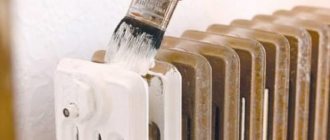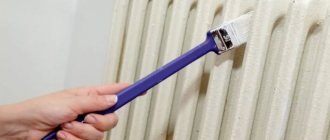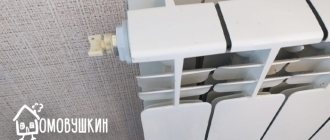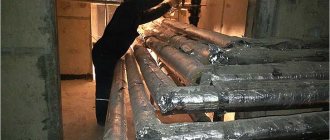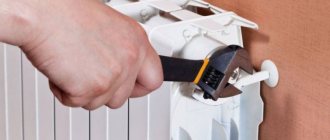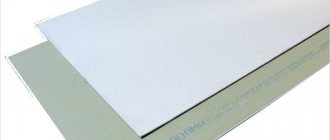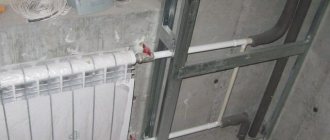Traditionally, many homeowners begin renovation work simultaneously with the heating season. Therefore, problems with the safety and reliability of old radiators do not go away, and you still have to paint the radiators during the heating season, whether you want it or not. It’s better to paint a hot heating pipe than to risk waiting a whole season until warm weather arrives.
You need to paint a hot surface quickly
Is it possible to paint heating radiators while hot?
In theory, all modern paints and varnishes were created exclusively for application to surfaces at operating temperatures of 15-30°C. All other painting options are considered abnormal, although on many packages you can find the inscription “paint for hot water pipes.” This does not mean that the manufacturer recommends painting a hot battery in a room; the company only assumes that after drying, the paint and varnish material can withstand the heating of the boiling point of water.
Conventionally, without any special restrictions, you can paint warm radiators at home with temperatures up to 50°C. This will not affect the quality or operating conditions of the radiators in any way. In all other cases, you will need to think several times before trying to organize painting of hot radiators in your apartment, when it is frosty outside, the heating season is in full swing, and there is practically no opportunity to fully ventilate the room.
Painting with acrylic disc paint
What are the dangers of trying to paint a hot battery at a temperature of 80-90°C:
- Rapid, and in some cases almost instantaneous evaporation of the solvent, resulting in the formation of clouds of toxic solvent components above the battery in the room;
- Quick setting of varnish base paint. Instead of a continuous and more or less uniform layer, a lumpy porous mass is obtained;
- The thickness of the paint layer increases by 1.5-2 times compared to conventional painting.
In some cases, elements of the hot water supply and heating system can be painted without any problems. For example, you can safely paint a riser - a hot heating pipe, it is of little use, most of the heat in the room is released through the radiator, so you can experiment with paint during the heating season.
If you have doubts about how suitable a paint material is for painting a heated surface, you can always try painting a hot radiator in the bathroom. Good ventilation, high-quality insulation of doors and a small volume of the room will help quickly remove solvent vapors from the room, so there is no risk in the experiment.
The brush “sticks” on a hot surface
Paint for hot radiators
It is immediately worth noting that paint and varnish materials should never be used to paint pipes and heating radiators that are heated, even up to 100°C. This list includes all paints and enamels whose solvent composition includes butyl, ethyl, methyl alcohol, toluene and xylene. The vapors of these substances become extremely toxic at high temperatures and can cause poisoning if inhaled.
The second type of paints prohibited for use for painting batteries during the heating season are nitro paints and nitro enamels. They contain acetone and ethyl alcohol, which has an extremely negative effect on working conditions. But that’s not even the point, the evaporation temperature of acetone is just over 40°C, so on hot batteries the nitro paint will swell in lumps and bubbles.
You can paint a heating radiator during the heating season:
- Oil varnishes and paints;
- Acrylic coatings;
- Alkyd paints and varnishes.
Polyurethane and epoxy materials for painting batteries during the heating season are not even considered.
Homemade paint for pipes during the heating season
Epoxy resins and paints are used to paint hot fittings and pipes, and even heating radiators, but this is done under specific industrial production conditions.
The coating looks like metal
At home, you can try to make your own painting material for hot water pipes based on epoxy glue EDP5, EDP5M, a small amount of thinner or acetone and filler from dry aluminum dust - silver. This option is attractive because:
- Paint for hot radiators is odorless;
- Excellent adhesion to cast iron and aluminum surfaces;
- Does not fade from heating during a long heating season.
In fact, this is the best thing available today if you need to paint a hot radiator in a living room, especially during the heating season. It is not without reason that most aluminum heating radiators in industry are coated with polyurethane-epoxy materials; the average durability of such a coating is several dozen heating seasons.
The negative aspects of homemade epoxy protection include two problems:
- It is difficult to find high quality epoxy resin with a modified phthalic-maleic hardener;
- A lengthy and labor-intensive process of selecting the optimal ratios of solvent, resin and hardener.
For each brand of resin and hardener, it is found only by trial and error. It turns out that in order to find the optimal recipe, you will need to paint the hot water pipe several dozen times. With luck, the problem is solved once and for all. It is clear that few people have the patience to experiment; it is easier to buy paint for hot heating pipes for one heating season than to waste time and effort looking for a universal solution.
You can paint hot radiators with enamel
Alkyd materials do not provide a high-density paint layer, so it is difficult to work with them. To get a thin and hard layer of paint, you need to apply several layers of paint, at least two. The first layer is applied to the ground and simply rubbed with maximum force on the metal. The starting coating is very durable, thin, with a matte surface. If there is little time left before the end of the heating season, then it is better to leave it in this form and paint the radiators already with the arrival of spring.
If the heating season has just begun, then it is better to apply the second layer of alkyd enamel using a spray bottle or aerosol can. If you need to paint immediately, you can also use a brush.
Primer for hot painting
Is it possible to paint hot batteries with acrylic paint?
Most often, acrylic paints are chosen to paint radiators already filled with hot water. They fit normally on a properly prepared surface and give a dense layer with a uniform color.
The only drawback is the high rate of water evaporation. Oxygen from the air and water are required for the acrylic mass to set. On hot pipes, the water base evaporates very quickly, so the surface can become rough and lack gloss. At the end of the heating season, you can paint the battery a second time or wait until the battery temperature drops.
The disadvantages of acrylic paints include a nasty smell, therefore, before painting the radiator, you will need to organize normal ventilation of the room, although the fumes from acrylic paints and varnishes are not as harmful as the fumes from alkyd solvents and nitro enamels.
Tips for painting bimetallic and aluminum radiators
Bimetallic and heating devices made of aluminum are painted in a factory with a powder composition. It will be extremely difficult to achieve this surface on your own, but if you still decide to refresh this device, then its surface for work must be prepared using the technology described above, and then covered with a primer mixture and a layer of alkyd enamel.
If there are strong imperfections, the coating should be removed down to the metal; a grinding machine is perfect for this. Next, the master will have to cover the surface with a primer mixture. Only after that we start painting.
(no votes yet)
Calculation of paint for batteries
Plan to use at least 250 ml of paint for one standard 8-register radiator. In order to paint with acrylic paints, one battery will require 40% more material.
Important! Oil paints are used extremely rarely for one simple reason. If you paint a battery during the heating season, then a few years later, when it’s time to renew the paintwork, it will be incredibly difficult to remove the old oil base. Due to the high temperature, drying oil polymerizes into a very strong and viscous film, which can only be removed by firing.
If nothing is at hand, and the situation requires intervention, then it is better to use classic PF-115 enamel. During the heating season, you can paint it with one layer, this will be enough to survive until the summer.
Painting
The painting process is actually not particularly difficult. But buying the first paint that comes to hand will still not be enough. There are special requirements for paint coating for batteries
Expert opinion
Grebnev Vadim Savelievich
Heating system installer
There are special compounds on sale that are designed specifically for coating radiators. But if for some reason they could not be found and purchased, you should pay special attention to the contents of the label.
The paint requirements are as follows:
- Heat resistance. It must withstand temperatures up to 100°C.
- Adhesion. The paint must adhere and not peel off when the temperature changes.
- Long lasting color fastness.
- Anti-corrosion. Such components provide protection to the radiator housing.
- No harmful ingredients.
Required tools and materials
To complete the work you will need a fairly large list of materials and tools:
- Electric drill with brush attachment, steel or bronze bristles;
- Hand wire brush;
- Rags for removing old paint;
- Coarse and medium grain sandpaper;
- Two brushes with short, stiff bristles; one will have to be cut and attached to a long handle at an angle;
- Table or floor fan;
- Respirator, gloves.
Advice! It is best to check purchased paint for hot heating pipes in advance for quality and drying speed on a hot surface.
At the height of the heating season, pipes heat up to an average of 80°C. It is believed that if the brush does not stick or burn to the pipe, and “ripples” and “crust” do not form on the laid layer, then it can be used to paint a heating radiator during the heating season.
How to clean a surface from old coating
Preparing the surface of radiators and pipes begins with removing the old paintwork. There are two simple ways to clean radiators:
- The mechanical method involves using a brush with metal bristles or an attachment to an electric drill. Dismantling the coating is carried out down to the metal, so it requires a lot of time and physical effort. The only drawback is the difficulty of processing small parts or hard-to-reach places. A special attachment for the drill simplifies the cleaning process, and it also allows you to better process the entire area of the device, even in hard-to-reach places.
- The chemical method requires the use of special chemical compounds based on acids and solvents that reduce the adhesion of the coating to the base. The surface is carefully treated with the selected composition according to the instructions until the paint is completely softened. Next, the old coating is removed with a spatula, grinder or brush.
We recommend: Double-circuit floor-standing gas boiler: specifics of device and choice
Preparatory work
First of all, you need to make room for painting the battery. Such a troublesome task as painting a radiator, especially during the heating season, requires removing all excess around the radiator and organizing normal ventilation of the room.
Use your hands to remove paint from heated metal in hard-to-reach places.
The first stage is usually the dirtiest and requires regular wet cleaning around the battery installation site. It will be useful to use a small vacuum cleaner, with which it is very convenient to collect dust from old paint, especially from behind and from under the registers.
Before tearing off the paint with an electric drill with a metal attachment, you need to protect the joints between the registers, it is best to wrap them with nylon cord. At high rotation speeds, hard bronze bristles instantly cut out the rubber and linen seal, and during the heating season this can have simply disastrous consequences.
After removing the top layer of paint, the metal will need to be carefully cleaned with sandpaper, especially on the recesses, ribs and slopes. This must be done manually, without an electric drill, otherwise, again, the risk of damaging the battery seriously increases.
The last step is to clean the metal from dust, wash the hot battery with a sponge or rag, always with clean water with a small addition of soda ash.
Important! During work, the room needs to be ventilated at least several times; there is no need to be afraid of cooling the room. The heat transfer power during the heating season is so great that after a few hours of ventilation, even in severe frost, the chances of defrosting the pipes are almost zero.
Glossy or matte
When choosing paint for heating radiators, you need to choose what type of surface you want to get - matte or glossy. You need to choose based on the type of surface. The fact is that glossy paint emphasizes surface unevenness. Cast iron batteries are most often painted, but their surface is far from ideal. By covering it with a glossy composition, you will only emphasize its imperfection.
Matte compositions are better in this regard - they visually hide many irregularities. So this is a good option. But there is also a drawback: matte white paint quickly acquires a grayish tint. This happens due to the fact that dust and dirt get clogged into the pores, and they are wide in matte paint. This dirt is not washed out from there. The solution is a fresh coat of paint or painting in a color other than white. A smart choice is to match the paint to the color of the walls. From a design point of view, this is a better solution than white radiators.
If there is a pattern on a cast iron radiator, the gloss will emphasize and highlight it
There is another way out - to repair the unevenness of the radiator. This is done using metal putty, you can use automotive putty. First, old paint, rust and other contaminants are removed, then the surface is degreased and then all irregularities are sealed with putty. After it dries, use sandpaper with medium, then fine grain, and sand the surface until smooth. Then it is dusted, primed and painted. In this case, you can safely use glossy enamels for heating radiators. If the surface is leveled carefully, you will be pleased with the result.
How to paint a hot radiator
Before painting, the cleaned and dried metal surface must be wiped again with a dry, clean cloth to remove any remaining soda deposits.
The sequence of work is as follows:
- Using an aerosol can or spray bottle, you need to paint the inner parts of the ribs and the walls of the registers. You can paint with a “crooked” brush, but the quality is noticeably lower. We take a break and ventilate the room;
- Using a lamp, we illuminate the dried layer of paint on the battery and determine the places where the paint did not adhere to the hot surface or the result was defective. Carefully clean it with emery cloth and blow air through the “insides”;
- Next, you need to remove all the protective cords and patches, paint the junction of the registers and pipes. Again, we dry, ventilate and inspect the results of the work. While the heating season is in progress, you cannot rub sandpaper on the joints;
- At the final stage it is necessary to paint the front part and sides of the registers. This should be done using a short-bristled brush. A small amount of paint is collected and carefully rubbed in a thin layer over the metal surface.
After most of the work has been done, the battery can be left in this form until the end of the heating season. In appearance, it is not much different from those painted in summer at normal temperatures. If conditions require completion of the work, you will need to apply a final coat of paint, preferably using a spray gun or a regular soft brush.
The front surface must be painted quickly. The paint material begins to boil on the surface, and a cloud of solvent appears above the hot battery. Therefore, if possible, you need to open the door and window, install a fan and actively blow the cloud outside the room.
It is very important that the surface has gloss
Painting process
Step by step guide to dyeing batteries:
- Turn off the heating and ventilate the room . It's worth waiting until it gets cold to prevent the paint from dripping. You should also make sure that the room is well ventilated. If you need to open several windows when the heating is turned off, then such a temporary cooling is still better than possible health problems associated with toxic paint composition.
- Clean the area around the radiator . It's best to use a vacuum cleaner to remove dust, hair, and anything that might stick to the paint. Then put any covering on the floor that you have at hand to prevent drops and splashes of paint.
- Apply (or spray) paint, ensuring that the layer is even . First of all, you need to paint the batteries inside, and then move on to the outside. Sections should be painted from top to bottom, otherwise the paint will fall on the already painted parts. If possible, it is better to avoid “overloading” the brush. If there is too much paint on the brush, it will cause drips and clumps.
- Wait , if necessary, apply another layer.
You must wait until the paint has completely dried. It is possible that the radiator may need another coat of paint once dry, but this is entirely dependent on the application process, the paint and the radiator. Most often, two coats are required for even painting. Moreover, two thin layers are better than one thick one. The second coat of paint is applied only after the previous one has completely dried.
The drying time of the paint is always indicated on the label.
Advice from experienced professionals
The last layer does not mean that the work is completely finished. If it is important to bring the appearance of the battery to perfect condition, then you can perform glossing or polishing. This is not only a struggle for the appearance of the radiator; a smooth surface releases significantly more heat into the air than a rough primed one. Moreover, it makes sense to do this during the heating season in order to improve the heating of the room.
In the simplest case, the front layer of paint is simply polished with a soft cloth dipped in soapy water. It is clear that working with a hot surface is not very comfortable, so you can go another way. For example, apply an additional layer of polyurethane or alkyd varnish that gives gloss. It is better to paint warm heating radiators with varnish, then the appearance of gloss is guaranteed.
The paint, no matter what it is - alkyd or nitro enamel, and even more so oil-based, is in a fairly plastic state due to the high temperature of the hot battery, so until the end of the heating season it is advisable to avoid any work with the radiator, do not try to put things on it, clean or use as a stand.


